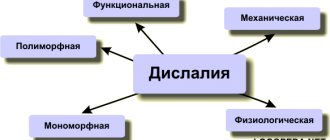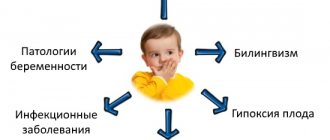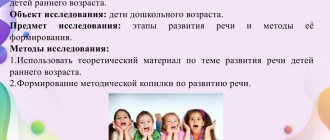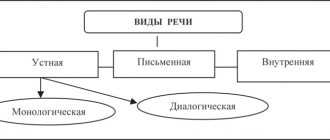Dysarthric speech disorders in children of early and preschool age
Dysarthria (speech motor disorder) is a violation of the pronunciation aspect of speech caused by insufficient innervation of the speech muscles. Dysarthria is a consequence of organic damage to the central nervous system, in which the motor mechanism of speech is disrupted. With dysarthria, it is not the programming of speech utterance that is impaired, but the motor implementation of speech. The leading defects in dysarthria are disturbances in the sound-pronunciation aspect of speech and prosody, as well as disturbances in speech breathing, voice and articulatory motor skills.
Speech intelligibility in dysarthria is impaired, speech is blurred and unclear. Main disorders (structure of the defect) in dysarthria
Impaired tone of articulatory muscles (facial muscles, tongue, lips, soft palate) such as spasticity, hypotension or dystonia. 1. Spasticity - increased tone in the muscles of the tongue, lips, face and neck. With spasticity, the muscles are tense. The tongue is pulled back “lumpy”, its back is spastically curved, raised upward, the tip of the tongue is not pronounced. The tense back of the tongue raised towards the hard palate helps soften consonant sounds (palatalization). Sometimes the spastic tongue is pulled forward with a “sting.” An increase in muscle tone in the orbicularis oris muscle leads to spastic tension of the lips, tightly closing the mouth (voluntarily opening the mouth is difficult). In some cases, with a spastic condition of the upper lip, the mouth may, on the contrary, be slightly open. In this case, increased salivation (hypersalivation) is usually observed. Active movements with spasticity of the articulatory muscles are limited. (Muscle spasticity is noted with spastic-paretic dysarthria.) 2. Hypotonia - decreased muscle tone. With hypotonia, the tongue is thin, spread out in the oral cavity; lips are flaccid and cannot close tightly. Because of this, the mouth is usually half-open, and hypersalivation may be expressed. Hypotonia of the muscles of the soft palate prevents the velum from moving sufficiently upward and pressing it against the back wall of the pharynx; a stream of air exits through the nose. In this case, the voice acquires a nasal tint (nasalization). (Hypotonia of articulatory muscles occurs with spastic-paretic and ataxic dysarthria.) 3. Dystonia is a changing nature of muscle tone. At rest, low muscle tone may be noted; when attempting to speak and at the moment of speech, the tone increases sharply. Dystonia significantly distorts articulation. A characteristic feature of sound pronunciation in dystonia is the inconstancy of distortions, substitutions and omissions of sounds. (Dystonia is noted with hyperkinetic dysarthria.)
In children with neurological pathology, a mixed and variable nature of tone disturbances in the articulatory muscles (as well as in the skeletal muscles) is often noted, i.e. in individual articulatory muscles, tone can change differently. For example, spasticity may be observed in the lingual muscles, and hypotonia in the facial and labial muscles. In all cases, there is a certain correspondence between tone disturbances in the articulatory and skeletal muscles. Impaired mobility of articulatory muscles. Limited mobility of the muscles of the articulatory apparatus is the main manifestation of paresis of these muscles.
Insufficient mobility of the articulatory muscles of the tongue and lips causes disturbances in sound pronunciation. When the lip muscles are damaged, the pronunciation of both vowels and consonants suffers. Articulation in general is impaired. Sound pronunciation is especially severely impaired when the mobility of the tongue muscles is sharply limited. The degree of impairment of the mobility of articulatory muscles can be different - from complete impossibility to a slight decrease in the volume and amplitude of articulatory movements of the tongue and lips. In this case, the most subtle and differentiated movements are disrupted first (primarily raising the tongue upward).
Specific violations of sound pronunciation : - persistent nature of violations of sound pronunciation, particular difficulty in overcoming them; - specific difficulties in automating sounds (the automation process requires more time than with dyslalia). If speech therapy classes are not completed on time, acquired speech skills often disintegrate; - the pronunciation of not only consonants, but also vowels is impaired (average or reduced vowels); - the predominance of interdental and lateral pronunciation of whistling [s], [z], [ts] and hissing [sh], [zh], [h], [sch] sounds; - deafening of voiced consonants (voiced sounds are pronounced with insufficient participation of the voice; - softening of hard consonant sounds (palatalization); - disturbances in sound pronunciation are especially pronounced in the speech stream. With an increase in speech load, general blurriness of speech is observed and sometimes increases.
Depending on the type of violation, all sound pronunciation defects in dysarthria are divided into two categories: anthropophonic (sound distortions) and phonological (substitutions, confusions). In dysarthric disorder, the most typical violation of the sound structure of speech is sound distortion.
Speech breathing disorders . Breathing disorders in children with dysarthria are caused by insufficient central regulation of breathing. Insufficient depth of breathing. The rhythm of breathing is disturbed: at the moment of speech it becomes more frequent. There is a violation of the coordination of inhalation and exhalation (shallow inhalation and shortened weak exhalation). Exhalation often occurs through the nose, despite the half-open mouth. Respiratory disorders are especially pronounced in the hyperkinetic form of dysarthria.
Voice disorders . Voice disorders are caused by changes in muscle tone and limited mobility of the muscles of the larynx, soft palate, vocal folds, tongue and lips. The most common symptoms are insufficient voice strength (quiet, weak, fading) and deviations in voice timbre (dull, nasal, constricted, hoarse, intermittent, tense, guttural).
In various forms of dysarthria, voice disturbances are of a specific nature. Violations of prosody (melodic-intonation and tempo-rhythmic characteristics of speech). Melody-intonation disorders are often considered one of the most persistent signs of dysarthria. They greatly influence the intelligibility and emotional expressiveness of speech. There is a weak expression or absence of vocal modulations (the child cannot voluntarily change the pitch). The voice becomes monotonous, poorly or unmodulated.
Violations of speech tempo are manifested in its slowing down, less often - in acceleration. Sometimes there are disturbances in the rhythm of speech (for example, chant - “chopped” speech, when there is an additional number of stresses in words).
Lack of kinesthetic sensations in the articulatory apparatus. In children with dysarthria, there is not only a limitation in the range of articulatory movements, but also a weakness in the kinesthetic sensations of articulatory postures and movements.
Autonomic disorders. One of the most common autonomic disorders in dysarthria is hypersalivation. Increased salivation is associated with limited movements of the tongue muscles, impaired voluntary swallowing, and paresis of the labial muscles. It is often aggravated due to the weakness of kinesthetic sensations in the articulatory apparatus (the child does not feel the flow of saliva) and decreased self-control.
Hypersalivation can be expressed to varying degrees. It can be constant or intensify under certain conditions. Even mild hypersalivation (moistening of the corners of the lips during speech, slight leakage of saliva) indicates the presence of neurological symptoms in the child. Less common are vegetative disorders such as redness or pallor of the skin, increased sweating during speech.
Violation of the act of receiving food. Children with dysarthria often have difficulty, and in severe cases, no chewing of solid food or biting off a piece. Choking and choking when swallowing are often observed. Difficulty drinking from a cup. Sometimes coordination between breathing and swallowing is impaired.
The presence of synkinesis. Synkinesias are involuntary accompanying movements when performing voluntary articulatory movements (for example, additional upward movement of the lower jaw and lower lip when trying to raise the tip of the tongue). Oral synkinesis - opening of the mouth during any voluntary movement or when attempting to perform it. Increased pharyngeal (gag) reflex. Loss of coordination of movements (ataxia).
Ataxia manifests itself in dysmetric, asynergic disorders and in the scantiness of the rhythm of speech. Dysmetria is a disproportion, inaccuracy of voluntary articulatory movements. It is most often expressed in the form of hypermetry, when the desired movement is realized in a more sweeping, exaggerated, slower movement than necessary (excessive increase in motor amplitude). Sometimes there is a lack of coordination between breathing, voice production and articulation (asynergia). Ataxia is noted with ataxic dysarthria.
The presence of violent movements (hyperkinesis and tremor) in the articulatory muscles. Hyperkinesis - involuntary, irregular, violent; There may be pretentious movements of the muscles of the tongue and face (hyperkinetic dysarthria). Tremor - trembling of the tip of the tongue (most pronounced during targeted movements). Tremor of the tongue is observed with ataxic dysarthria.
From the book Prikhodko O. G. “Speech therapy massage for the correction of dysarthric speech disorders in children of early and preschool age.
Speech therapy program
Dysarthria is a pathology that requires persistent, long-term work by the speech therapist, the patient, his relatives and caregivers. A speech map of a speech therapy examination for dysarthria is drawn up. The speech therapy support program is approved after receiving a speech therapy report for dysarthria and recommendations from a neurologist who treats the disease that has caused speech impairment. Speech therapy classes for dysarthria begin as early as possible.
There are the following main areas of speech therapy work for dysarthria:
- Normalization of motor skills of the articulatory apparatus;
- Development of articulatory movements;
- Formation of the ability to voluntarily switch movable organs of articulation from one movement to another at a given pace;
- Overcoming monotony and speech tempo disturbances;
- Full development of phonemic awareness.
The importance of the early start of speech therapy work for dysarthria cannot be overestimated. Speech therapists at the Yusupov Hospital begin to work on restoring speech in patients who have suffered a stroke or acute traumatic brain injury, immediately after the patient’s consciousness has been restored. For demyelinating diseases of the nervous system, speech therapy work is included in the rehabilitation program.
When carrying out correctional speech therapy work, the following speech therapy methods are used:
- Voice and breathing exercises;
- Active and passive articulatory gymnastics;
- Differentiated speech therapy massage (relaxing or stimulating);
- Acupressure, probe, brush, manual massage;
- Artificial local contrastothermy (combination of exposure to low and high temperatures).
Speech therapy for dysarthria is based on compliance with the following principles:
- Systematic approach to the analysis of speech defects;
- Stage-by-stage interconnected formation of all components of speech;
- Regulation of children's mental activity through the development of generalizing and communicative functions of speech.
In the process of systematic long-term training, a gradual normalization of the motor skills of the articulatory apparatus, the development of articulatory movements, and the formation of the ability to voluntarily switch the movable organs of articulation from one movement to another at a given pace are carried out. Monotony and disturbances in the tempo of speech are overcome, and full-fledged phonemic perception develops. This prepares the basis for the development and correction of the sound side of speech.
Stages of speech therapy work
Speech therapy work for dysarthria is carried out in stages. The main goal of the first, preparatory stage is to prepare the articulatory apparatus for the formation of articulatory patterns, correction of breathing and voice. An important task at this stage is the development of sensory functions, especially auditory perception and sound analysis, as well as the perception and reproduction of rhythm. Speech therapy work is carried out against the background of medication and physiotherapeutic treatment, massage and physical therapy.
At the second stage, primary communicative pronunciation skills are formed. Its main goal is the development of speech communication and sound analysis. The speech therapist works to correct articulation disorders. In case of spasticity, they work on relaxing the muscles of the articulatory apparatus. Control over the position of the mouth is developed, articulatory movements develop, speech breathing is corrected, the voice, sensations of articulatory movements and articulatory praxis develop.
The formation of sound pronunciation in dysarthria includes the production and consolidation of sounds in speech. The first group of sounds includes phonemes that are the easiest in terms of articulation and acoustically distant from each other. These are the sounds a, y, p, m, n, k, s, x, v, o, l, t, s. These sounds, being the simplest ones, are worked out to the norm. Along the way, these phonemes are used to develop phonemic perception and sound analysis skills (identifying sounds from a number of others, from syllables, in simple words).
Tongue twisters for dysarthria are a phonetic means of developing the mobility of the articulatory apparatus. When using tongue twisters, adhere to the following recommendations:
- The work begins with simple, short, rhyming phrases (“White sheep beat the drums”);
- The principle of selection of didactic material is observed (the tongue twister should not contain words with sounds that are poorly pronounced by the patient;
- Tongue twisters are best used in games.
An individual approach to the selection of means and methods of speech therapy work at each stage of treatment for dysarthria allows specialists at the Yusupov Hospital to achieve speech restoration in patients who were abandoned in other rehabilitation centers.
Logorhythmic influence
Logorhythmic work with patients suffering from dysarthria includes therapeutic exercises in classes. It is built depending on the speech therapy correction course. It is divided into 3 periods.
The tasks of the first period are as follows:
- Education of static movements;
- Development of fine motor skills of the fingers;
- Development of general movements of the upper and lower extremities, torso with the gradual introduction of exercises with objects;
- Development of muscles that provide facial expressions;
- Development of various types of memory, auditory and visual attention;
- Gradual formation of normal diaphragmatic skill;
- Overcoming prosodic disturbances in dysarthria.
To activate the prosodic components of speech, singing is used primarily. The development of the prosodic side of speech in dysarthria is carried out with the help of dramatizations of songs, during the performance of which it is necessary to change the strength, timbre, and pitch of the voice. To normalize vocal function, articulatory and breathing exercises and movements for the muscles of the neck and head are performed.
In the complex of medical and speech therapy effects, logorhythmic classes contribute to:
- Development of the articulatory apparatus;
- Voice training (pitch, timbre, strength, range, strength);
- Breathing development (inhalation depth, duration of speech inhalation and exhalation).
Systematic work started in a timely manner contributes to the rapid restoration of speech function.










